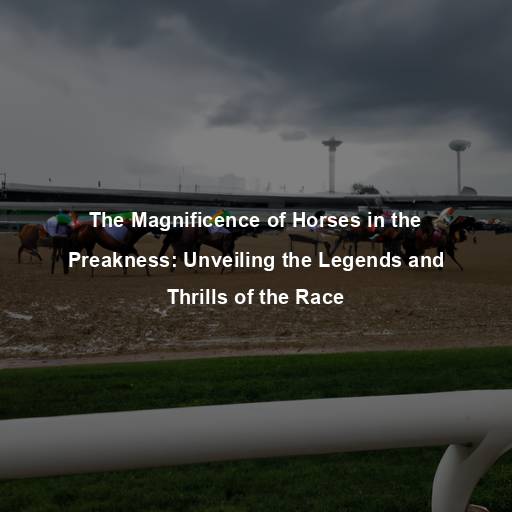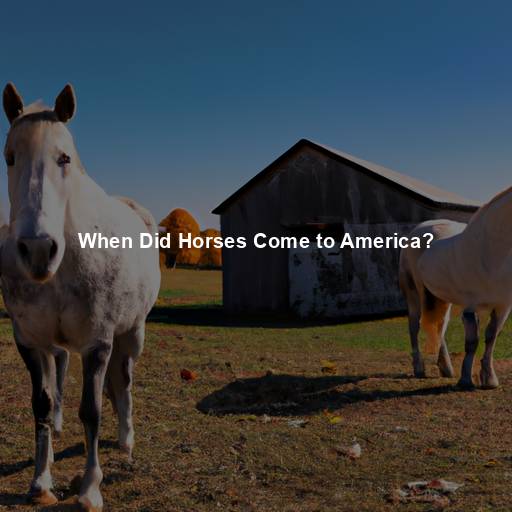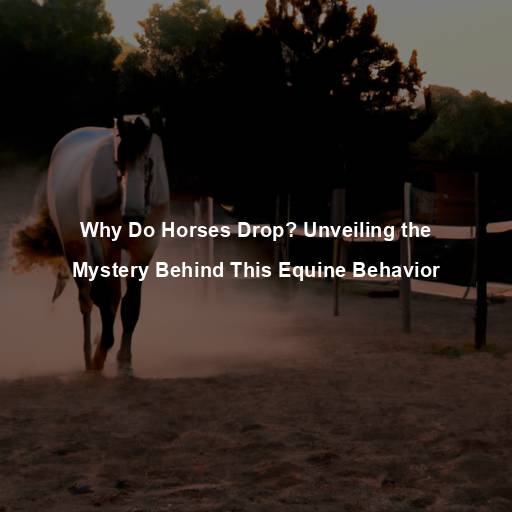Did Horses Die at the Kentucky Derby? Unveiling the Truth Behind the Iconic Horse Racing Event
Last Updated on November 12, 2023 by Evan
Contents [hide]
- 1 Unraveling the Mysteries of the Kentucky Derby
- 1.1 A Horse Racing Legacy
- 1.2 The Dark Side of Horse Racing
- 1.3 Understanding the Risks
- 1.4 The Tragic Losses
- 1.5 Safety Measures and Reforms
- 1.6 The Kentucky Derby Today
- 1.7 The Ongoing Journey Towards Safety
- 1.8 Track Surfaces: Paving the Way to Safety
- 1.9 Medication Regulations: Promoting Fairness and Horse Welfare
- 1.10 Pre-Race Examinations: A Thorough Assessment
- 1.11 Jockey Training: Skill and Safety Go Hand in Hand
- 2 The Importance of Public Awareness and Education
- 3 The Power of Collaboration and Continuous Improvement
- 4 The Global Impact of Horse Racing Safety Measures
- 5 Looking Ahead: The Future of Horse Racing Safety
- 6 FAQs: Did Horses Die at the Kentucky Derby?
- 6.1 Are there any recorded cases of horses dying during the Kentucky Derby?
- 6.2 How often do horses die at the Kentucky Derby?
- 6.3 What causes the horses to die at the Kentucky Derby?
- 6.4 How does the horse racing industry address horse deaths at the Kentucky Derby?
- 6.5 What happens when a horse suffers a fatal injury during the Kentucky Derby?
- 6.6 How does the Kentucky Derby organization respond to horse deaths?
- 6.7 Is anything being done to further reduce horse deaths at the Kentucky Derby?
Unraveling the Mysteries of the Kentucky Derby
The Kentucky Derby, often referred to as “The Most Exciting Two Minutes in Sports,” is a prestigious horse racing event that captivates the hearts of millions around the world. This annual tradition takes place on the first Saturday in May at Churchill Downs in Louisville, Kentucky. With its rich history, glamour, and unparalleled excitement, the Kentucky Derby has become an iconic symbol of the horse racing world. However, amidst the glitz and glamour, there have been unfortunate incidents that have raised concerns about the welfare of the horses participating in this legendary race.
A Horse Racing Legacy
Horse racing has a long and storied legacy, dating back centuries. The thrill of watching magnificent thoroughbreds thundering down the racetrack, their hooves pounding the ground beneath them, has been a source of exhilaration for both spectators and participants. The Kentucky Derby, established in 1875, has become one of the most esteemed events in the horse racing calendar, attracting top-tier horses, skilled jockeys, and a global audience.
The Dark Side of Horse Racing
While the Kentucky Derby brings forth a spectacle of elegance and excitement, it cannot be denied that horse racing, as an industry, has faced its fair share of criticism and controversy. One of the primary concerns revolves around the welfare and safety of the horses involved. Tragically, there have been instances of horses sustaining fatal injuries during races, including the Kentucky Derby itself.
Understanding the Risks
Horse racing is an inherently risky sport, both for the horses and the jockeys. The sheer speed, physical exertion, and competitive nature of the races create an environment where accidents can happen. Despite the implementation of various safety regulations and advancements in veterinary care, the risk of injuries and fatalities remains a reality in this high-stakes sport.
The Tragic Losses
Over the years, several horses have met untimely deaths at the Kentucky Derby. One such heart-wrenching incident occurred in 2008 when the magnificent filly Eight Belles suffered catastrophic injuries after finishing second in the race. The entire racing community was left devastated by her tragic demise, igniting a wave of discussions about the safety measures in place for these magnificent animals.
Safety Measures and Reforms
In the wake of tragic events like the heartbreaking loss of Eight Belles, the horse racing world has been galvanized into action, striving to address the pressing safety concerns that plague the sport. Eager to turn the tides, the industry has embarked on a journey of stringent regulations, concentrating on critical components such as track surfaces, medication practices, and pre-race evaluations. Moreover, thanks to significant breakthroughs in veterinary care and cutting-edge treatments, the risks entwined with horse racing are gradually being untangled, shedding rays of hope amidst the chaos.
The Kentucky Derby Today
In recent years, the Kentucky Derby has witnessed a decline in the number of horse fatalities. The organizers and stakeholders of the event have made concerted efforts to prioritize the safety and well-being of the horses, ensuring that they are in optimal condition before competing. Rigorous veterinary inspections, state-of-the-art track surfaces, and comprehensive training programs have all contributed to a safer racing environment.
The Ongoing Journey Towards Safety
While significant progress has been made, the horse racing community acknowledges that there is still work to be done. The pursuit of a safer sport requires continuous evaluation, research, and implementation of new safety measures. The welfare of the horses must remain at the forefront of all decision-making processes, ensuring that the Kentucky Derby and other horse racing events become synonymous with both excitement and compassion.
Track Surfaces: Paving the Way to Safety
Ensuring the utmost safety of our beloved equine companions in the exhilarating realm of horse racing has always been a paramount concern. The evolution of track surfaces has witnessed an intriguing journey, brimming with uncertainty and intrigue. In the early days, dirt or turf tracks, while beloved by the purists, could often become imbalanced and precarious, potentially endangering the gallant horses. However, with the advent of cutting-edge technology, a wave of synthetic track surfaces, exemplified by the impressive Polytrack and Tapeta, has surged forward.
Medication Regulations: Promoting Fairness and Horse Welfare
The administration of medication to racehorses has been a subject of much debate within the horse racing community. In the past, the use of certain medications, such as painkillers and anti-inflammatory drugs, was widespread. However, concerns arose regarding the potential masking of injuries and the impact on horse welfare. To address these issues, stricter regulations have been put in place to limit medication usage and ensure that horses are not competing under the influence of substances that may compromise their well-being.
Pre-Race Examinations: A Thorough Assessment
Before taking part in prestigious events such as the Kentucky Derby, thoroughbred horses are subjected to a series of rigorous pre-race evaluations. These assessments are designed to meticulously scrutinize the horses’ physical condition, detect even the slightest hint of potential health issues or injuries that might compromise their safety during the race. Experienced veterinarians conduct comprehensive examinations, meticulously assessing the horses’ vital signs, musculoskeletal health, and overall fitness. In the event that any concerns or anomalies are flagged, the horse may be withdrawn from the race to receive the necessary treatment and allow for a full recovery.
Jockey Training: Skill and Safety Go Hand in Hand
As the attention often centers around the well-being of horses, it is crucial to recognize the integral role of jockeys in ensuring a secure racing environment. Jockeys undergo extensive training programs, honing their riding skills, balance, and effective communication with the horses. This comprehensive training not only improves their performance but also underscores the paramount importance of horse welfare and safety. Jockeys are instructed on responsible horse handling, enabling them to swiftly make decisions that prioritize the horse’s welfare, even in the midst of the intense racing atmosphere.
The Importance of Public Awareness and Education
Promoting Transparency for Public Trust
In a world where the fate of horse racing hangs in the balance, the key lies in enlightening the masses. With every stride, the Kentucky Derby races toward a future that hinges on transparency and clear communication. A harmonious blend of safety measures, stringent regulations, and unwavering commitment to horse welfare will pave the path to public trust. By delving deep into the transformative efforts undertaken within the industry, misconceptions can be shattered, allowing the public to make judgment calls rooted in knowledge and understanding.
Supporting Research and Innovation
To create a safer environment for horses in horse racing, ongoing research and innovation are vital. Collaborations between veterinarians, scientists, and industry stakeholders can lead to groundbreaking advancements in horse health and safety. By investing in research initiatives, such as studying track surfaces, analyzing injury patterns, and developing new preventive measures, the horse racing community can continue to enhance the safety standards and protocols in place. The knowledge gained from such research can shape the future of the sport, making it safer for both horses and jockeys.
Encouraging Responsible Ownership and Breeding Practices
Ensuring the welfare and longevity of racehorses is a complex jigsaw puzzle, with responsible ownership and breeding practices serving as crucial pieces. These stalwart guardians wield immense power in the well-being of these majestic creatures, shaping their destinies from birth to the finish line. By meticulously selecting horses of robust genetics and optimum health and nurturing them with top-notch care and training, these custodians become the unsung heroes behind the scenes, preserving the safety and lifespans of these magnificent athletes. In this odyssey of equine excellence, educational programs and proactive initiatives showcasing the tenets of responsible horse ownership become indispensable allies, fortifying this collective mission of perpetual welfare.
The Power of Collaboration and Continuous Improvement
The majestic world of horse racing, with its dazzling spectacles and heart-pounding moments, holds within it a perplexing paradox. While this sport, epitomized by illustrious events like the Kentucky Derby, exudes an aura of glamour and tradition, there lingers an urgency to tackle the enigmatic question of equine well-being. Amidst the whirlwind of excitement, the key lies in the hands of a heterogeneous tapestry of individuals – horse racing organizations, strict regulators, unwavering track officials, devoted owners, skilled trainers, fearless jockeys, and vigilant veterinarians. Only through their harmonious collaboration, a symphony avant-garde of knowledge-sharing, implementation of best practices, and an unwavering commitment to constant evolution, can the industry transcend the confines of conventional norms and pave the way towards a safer haven for these noble steeds.
Embracing Change for a Safer Future
The landscape of horse racing has witnessed significant strides in acknowledging and tackling the safety apprehensions associated with the sport. Yet, it is crucial to comprehend that the quest for a safer future remains a perpetual quest. With the continuous advancement of technology and the unveiling of new research findings, the industry finds itself entangled in a perplexing maze of possibilities and uncertainties. Navigating this maze necessitates a posture of adaptability and a willingness to embrace change.
Equine Biomechanics: Gaining Insight into Horse Movement
In a realm where technology is king, there lies a captivating domain that has reshaped the very essence of equine biomechanics. With a mesmerizing display of high-speed cameras and motion sensors, scientists and trainers delve deep into the enigmatic world of horse movement. As every stride is calculated and every joint analyzed, intricate details unfold, revealing the mysteries hidden within a horse’s gait. This intriguing data serves as a compass, guiding them towards a treasure trove of understanding, where potential areas of stress and imbalance are unveiled, offering a glimmer of hope to prevent injuries.
Diagnostic Imaging: Early Detection of Injuries
Diagnostic imaging techniques, such as X-rays, ultrasounds, and magnetic resonance imaging (MRI), have become invaluable tools in identifying and assessing injuries in racehorses. These non-invasive procedures allow veterinarians to visualize the internal structures of the horse’s body, including bones, ligaments, and tendons. By detecting injuries at an early stage, trainers and veterinarians can intervene promptly, implementing appropriate treatments and rehabilitation protocols. The use of diagnostic imaging has significantly contributed to reducing the risk of catastrophic injuries during races.
Virtual Reality Simulations: Enhancing Jockey Training
Immersing themselves in a digital realm, jockeys are now embracing the realm of virtual reality (VR) simulations as a pivotal training tool. These cutting-edge simulations offer a secure and controlled space for jockeys to fine-tune their racing skills, enabling them to navigate the ever-unpredictable domain of racing scenarios without compromising their safety. By immersing themselves in these virtual races, jockeys acquire valuable insight into the art of decision-making, perfecting their sense of timing, and mastering the intricate art of maneuvering. With the ability to explore an array of tracks, weather conditions, and racing scenarios, jockeys become adept at adapting to unexpected challenges that may transpire during races such as the illustrious Kentucky Derby.
The Global Impact of Horse Racing Safety Measures
International Collaboration: Learning from Each Other
Across the globe, the tireless pursuit of safer horse racing is not limited to one corner of the world or a solitary event. Communities of equestrian enthusiasts from all walks of life actively work together, reaching across borders to exchange invaluable insights, experiences, and solutions in an effort to bolster safety standards collectively. From international conferences where minds collide, to fruitful research collaborations and the sharing of information, a united global front emerges, committed to ensuring the wellbeing of our beloved equine companions in the realm of racing. By embracing a culture of learning from one another’s triumphs and tribulations, the industry sets the stage for constant growth and the creation of an environment where horses can flourish, no matter where they race.
Inspiring Positive Change: Setting a Precedent
The harmonious synergy between the horse racing realm and the realm of equine wellness extends far beyond mere boundaries, my dear readers. With an unwavering dedication to the welfare of our majestic creatures, the horse racing industry has paved a winding path towards progress and instigated a veritable revolution. Behold the stringent regulations, the ever-advancing tapestry of research, and the embrace of cutting-edge technology, all swirling in a mesmerizing dance to sculpt a future brimming with compassion towards our beloved steeds. The illustrious Kentucky Derby, a resplendent ode to elegance and horsepower, stands tall as a shining beacon of inspiration, urging other sectors to unmask their practices and reshape their priorities to provide unparalleled care for the animals entrusted in their reverent care.
Education and Advocacy: Spreading Awareness
The fascinating world of horse racing thrives on public awareness and education, which are indispensable in shaping its perception and future. It is the shared responsibility of horse racing organizations and animal welfare advocates to champion transparency and disseminate knowledge about the myriad safety measures and innovations put in place. By engaging in open dialogue, addressing concerns head-on, and sharing tales of triumph, the industry can start dismantling misconceptions and foster trust within the wider community. Through enlightening educational initiatives, both seasoned racegoers and curious onlookers alike can develop a profound appreciation for the tireless efforts dedicated to ensuring the welfare and security of these majestic creatures in prestigious events like the illustrious Kentucky Derby and beyond.
Looking Ahead: The Future of Horse Racing Safety
Innovation and Adaptation: Embracing Change
Ensuring the safety of horses in the world of racing is an unending quest, where adaptability is key. As technology progresses, new doors open for enhancing safety in this age-old sport. Think futuristic, with track surfaces that absorb impact, wearable sensors that monitor horse health in real-time, and groundbreaking advancements in vet medicine contributing to the constant betterment of safety protocols. By embracing change and being at the vanguard of innovation, the horse racing community can preserve the excitement of events like the Kentucky Derby, while always prioritizing the wellness of these majestic creatures.
The Role of Regulation: Striking a Balance
Regulatory bodies have a critical role to play in maintaining the integrity and safety of horse racing. Striking a balance between competition and horse welfare is paramount. Continual assessment and adjustment of regulations based on emerging research and best practices will help ensure that safety standards keep pace with the evolving nature of the sport. Collaborative efforts between industry stakeholders, regulatory bodies, and animal welfare organizations can help shape effective regulations that prioritize horse safety without compromising the excitement and competitiveness of races like the Kentucky Derby.
FAQs: Did Horses Die at the Kentucky Derby?
Are there any recorded cases of horses dying during the Kentucky Derby?
While the Kentucky Derby is undoubtedly a prestigious horse racing event, unfortunate occurrences of horse deaths have, unfortunately, been recorded in the history of the race. Over the years, there have been instances where horses participating in the Kentucky Derby have suffered fatal injuries, which ultimately led to their deaths.
How often do horses die at the Kentucky Derby?
Thankfully, horse fatalities at the Kentucky Derby are relatively rare. The race organizers and participants take extensive measures to prioritize the safety and well-being of the horses involved. Through strict regulations, improved track conditions, and constant advancements in veterinary care, the number of horse deaths has significantly decreased over time. Nevertheless, although infrequent, there still have been instances where horses were fatally injured during the race.
What causes the horses to die at the Kentucky Derby?
When it comes to the unfortunate outcome of a horse’s life in the midst of an eagerly anticipated event like the Kentucky Derby, one cannot simply brush off the multitude of factors at play. The intense demands of the race place a considerable burden on these majestic creatures, pushing their bodies to their physical limits. This colossal strain can result in a grim array of injuries, such as fractures, dislocations, or catastrophic falls, which may ultimately seal their fates. Yet, it is crucial to acknowledge that the precise causes of these heart-wrenching incidents remain subject to the intricate web of circumstances surrounding each occurrence.
How does the horse racing industry address horse deaths at the Kentucky Derby?
In recent times, the world of horse racing, with its crown jewel the Kentucky Derby, has found itself at a crossroads, grappling with the gravely unfortunate occurrences that have unfolded on its tracks. To combat this disarray, the powers that be have embraced a whirlwind of change with an eye toward safety. They’ve ramped up their efforts by enforcing stringent protocols, revamping track surfaces, altering race distances, elevating veterinary practices, and intensifying pre-race scrutinies. Moreover, there has been an intensified focus on analyzing the aftermath of races and closely monitoring any potential hazards, all in an earnest endeavor to fortify safety measures and forge a more secure future.
What happens when a horse suffers a fatal injury during the Kentucky Derby?
When a horse suffers a fatal injury during the Kentucky Derby, immediate medical attention is provided by the on-site veterinary team. Despite their efforts, if the injury is severe or untreatable, the horse may be euthanized to prevent further suffering. The equine industry is committed to the ethical treatment of horses, and difficult decisions regarding euthanasia are made with their welfare in mind.
How does the Kentucky Derby organization respond to horse deaths?
The Kentucky Derby organization takes horse deaths very seriously and works diligently to prevent future incidents. Each fatal injury undergoes investigation and analysis to identify potential causes and areas for improvement. The organization collaborates with industry experts and stakeholders to implement necessary changes, striving to make the race as safe as possible for both horses and jockeys.
Is anything being done to further reduce horse deaths at the Kentucky Derby?
The Kentucky Derby and horse racing as a whole have been a hotbed of concern and conversation due to the unfortunate deaths of horses. However, it’s important to acknowledge the industry’s commitment to addressing this issue. Extensive research, cutting-edge technology, and groundbreaking safety measures are constantly being implemented to not only identify but also prevent potential dangers. The focus is firmly on establishing a safer environment for these magnificent creatures, with the undeniable aim of significantly reducing fatal injuries during high-stakes races like the Kentucky Derby.







